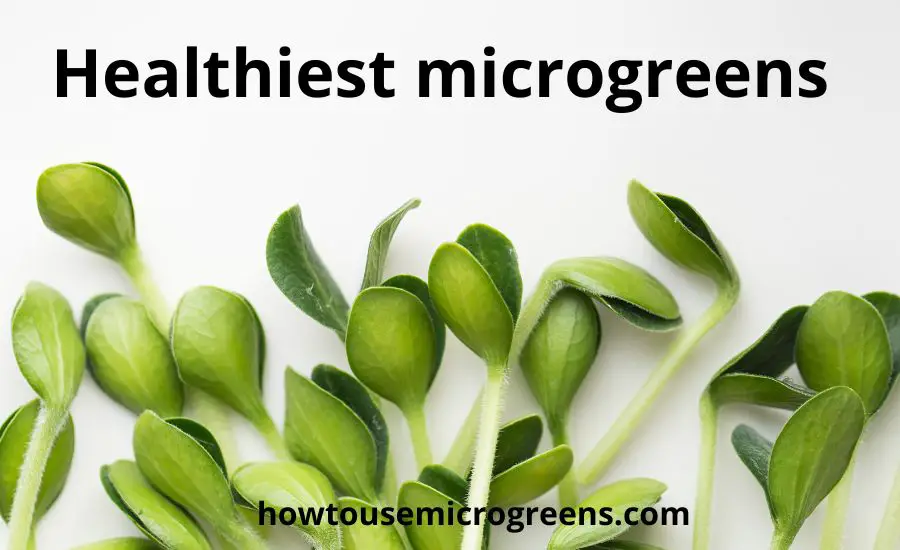Microgreens are tiny, immature plants that have grown in favor of a healthful and nutritious complement to meals in recent years.
These small plants are harvested after the seedling stage but before the plant matures, making them nutrient-rich. While there are many various kinds of microgreens, some are especially healthful due to their high vitamin content.
We will look at some of the healthiest microgreens and their possible health benefits.
Microgreens are a terrific method to increase your nutritional consumption and improve your health, whether you are a health enthusiast or simply trying to add some variety to your diet.
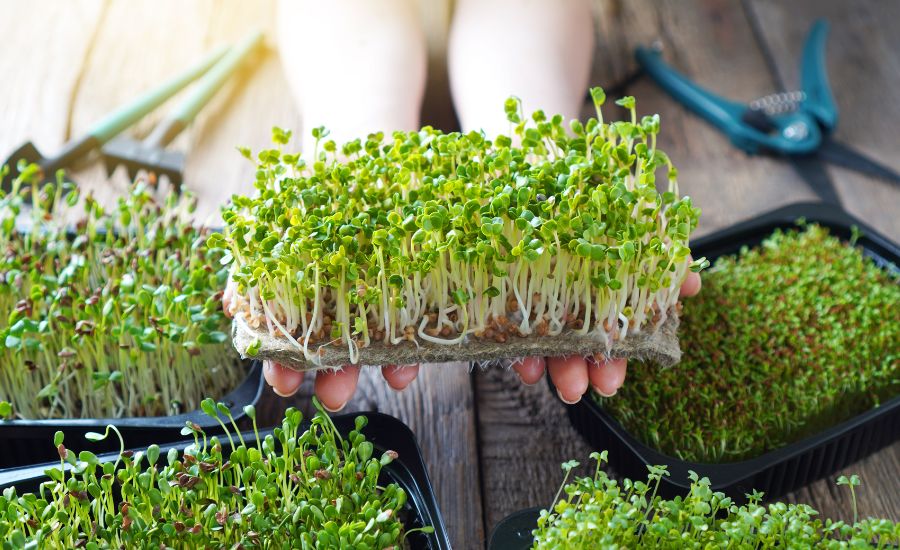
Contents
Types of microgreens
There are dozens of various kinds of microgreens, each with its distinct flavor and nutritional profile.
The following are some of the most common types of microgreens.
Arugula microgreens
Arugula microgreens are one of the most nutritious microgreens and are a fragile variant of the popular salad green arugula.
Because these small greens, Arugula microgreens are harvested while the plant is only a few inches tall, they are high in nutrition, flavor, and texture.
Moreover, arugula seeds have the same price as broccoli.
The flavor of arugula microgreens is comparable to that of mature arugula leaves. Arugula microgreens can be used to lend a robust and spicy flavor to a range of meals, including salads, sandwiches, and pizzas.
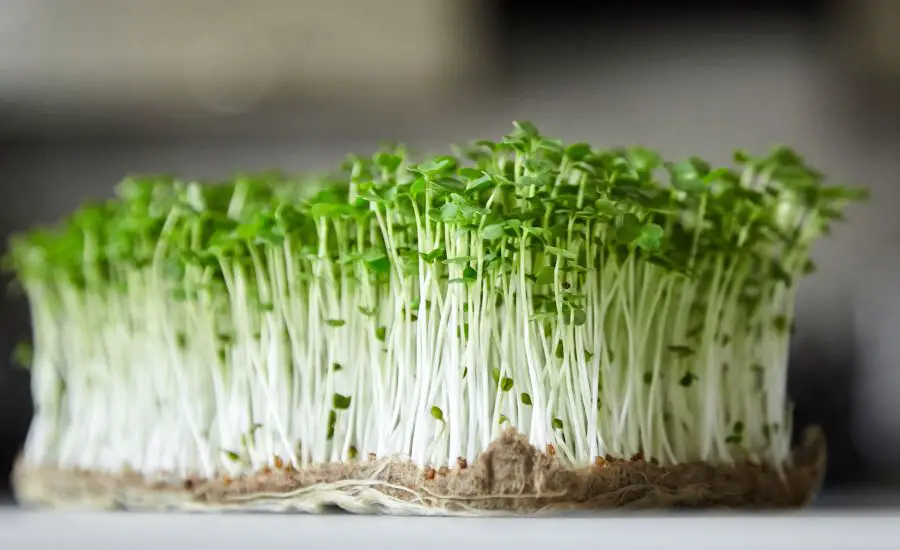
Basil microgreens
Basil microgreens are one of the most nutritious microgreens and are a popular type of microgreen with a distinct flavor and a variety of possible health advantages.
Basil microgreens have a pleasant, aromatic flavor that is identical to mature basil leaves and is harvested while the plant is just a few inches tall.
Basil microgreens can be used to bring a burst of fresh taste to several cuisines, including salads, sandwiches, and pasta dishes.
Broccoli microgreens
Broccoli microgreens are one of the best microgreens and they are immature plants harvested after sprouting but before reaching maturity.
Because broccoli microgreens, small greens are high in nutrients such as vitamins C, E, and K, minerals, and antioxidants, they are a popular complement to a healthy and good diet.
Broccoli microgreens and broccoli seeds have been discovered to have up to 40 times the nutrients of mature broccoli, which is a source of nutrients on its own.
Broccoli microgreens are high in vitamins A, C, e, and K and calcium, iron, and fiber. Broccoli microgreens also include sulforaphane, a chemical with anti-cancer effects that may help decrease cholesterol levels.
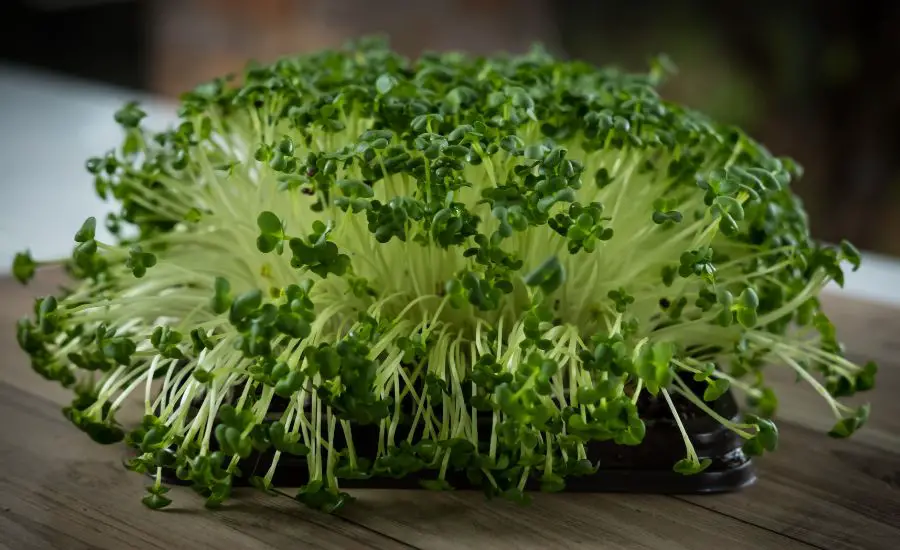
Onion microgreens
The flavor of onion microgreens is mild and sweet, similar to mature green onions. They can be used to bring a fresh and delicate flavor to several foods, including salads, sandwiches, and stir-fries.
Cilantro microgreens
Cilantro microgreens are one of the best microgreens and they are the fragile and young variant of the popular herb cilantro. Because these small greens are harvested while the plant is only a few inches tall, they are high in nutrition, flavor, and texture.
Cilantro microgreens have a similar fresh and zesty flavor to mature cilantro leaves.
Cilantro microgreens can be used to provide a spicy flavor to several foods, including salads, tacos, and soups.

Kale microgreens
Kale microgreens are one of the best microgreens and they are the fragile variant of the common leafy green kale. Because these small greens are harvested while the plant is only a few inches tall, they are high in nutrition, flavor, and texture.
Kale microgreens have the same mild, somewhat sweet flavor as mature kale leaves. They can be used to enhance the flavor of certain foods, including salads, sandwiches, and smoothies.
Kale microgreens may also provide health benefits, according to research. One study discovered that kale microgreens may help lower inflammation in the body. Another study showed that kale microgreens may have antioxidant effects, which may help reduce the development of chronic diseases.
Kale microgreens are simple to grow at home and ready to harvest in a matter of weeks. They are an excellent complement to a balanced diet, as they can increase nutritional intake while giving a gentle and sweet flavor to your meals.
Mustard microgreens
Mustard microgreens are the fragile young leaves of the mustard plant and are best eaten raw. Because these small greens are harvested while the plant is only a few inches tall, they are high in nutrition, flavor, and texture.
Mustard microgreens have a pungent, peppery flavor reminiscent of adult mustard greens. They can be used to lend a robust and zesty flavor to several foods, including salads, sandwiches, and stir-fries.
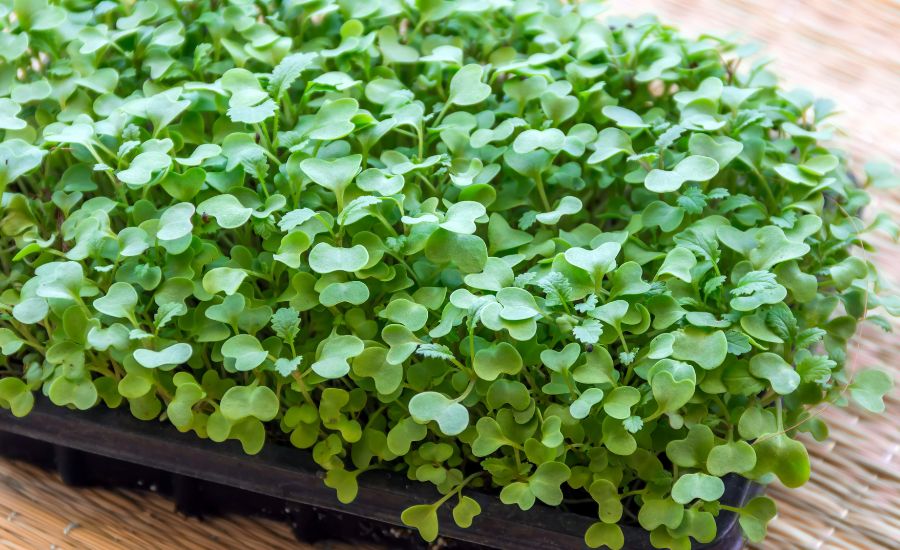
Pea microgreens
Pea microgreens, or Pea shoots are the pea plant’s immature and fragile form. Because these small greens are harvested while the plant is only a few inches tall, they are high in nutrition, flavor, and texture.
Pea microgreens are sweet and delicate, similar to mature pea shoots. They can be used to bring a fresh and sweet flavor to several foods, including salads, sandwiches, and soups.
Beet microgreens
Beet microgreens are the plant’s immature and fragile form. Beetroot microgreens are harvested while the plant is only a few inches tall, they are high in nutrition, flavor, and texture.
Beet microgreens have a flavor that is slightly sweet and earthy, similar to mature beet leaves. They can be used to offer a nutritious and colorful boost to several cuisines, including salads, sandwiches, and smoothies.
Beet microgreens are not only delicious, but they are also high in nutrients. They include plenty of vitamins A, C, and K, as well as minerals like calcium, iron, and potassium. They also contain antioxidants, which can help protect cells from free radical damage.
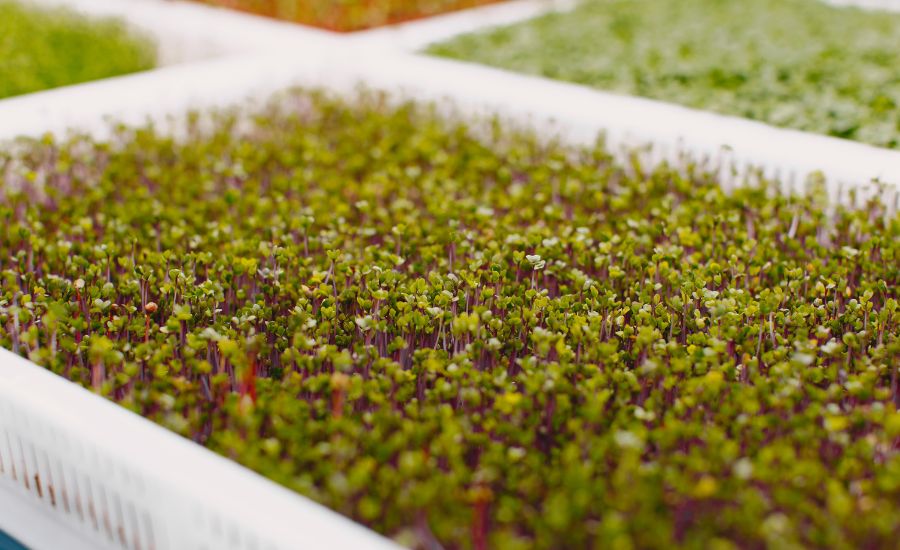
Radish microgreens
Radish microgreens are the immature and sensitive form of the well-known radish root vegetable. Because these small greens, Radish microgreens are harvested while the plant is only a few inches tall, they are high in nutrition, flavor, and texture.
Radish microgreens have a particular flavor that is peppery and acidic, similar to mature radish roots. Radish microgreens can be used to lend a peppery punch to salads, sandwiches, and tacos, among other things.
In addition to their distinct flavor, radish microgreens are an excellent source of nourishment. Radish microgreens include plenty of vitamins A, C, and K, as well as minerals like calcium, iron, and potassium.
Radish microgreens also contain antioxidants, which can help protect cells from free radical damage.
Radish microgreens are simple to raise at home and ready to harvest in a matter of weeks. Radish microgreens are an excellent addition to a healthy diet, as they may help you increase your nutrient intake while also adding flavor to your meals. Radish microgreens taste just like the peppery radish bulb.
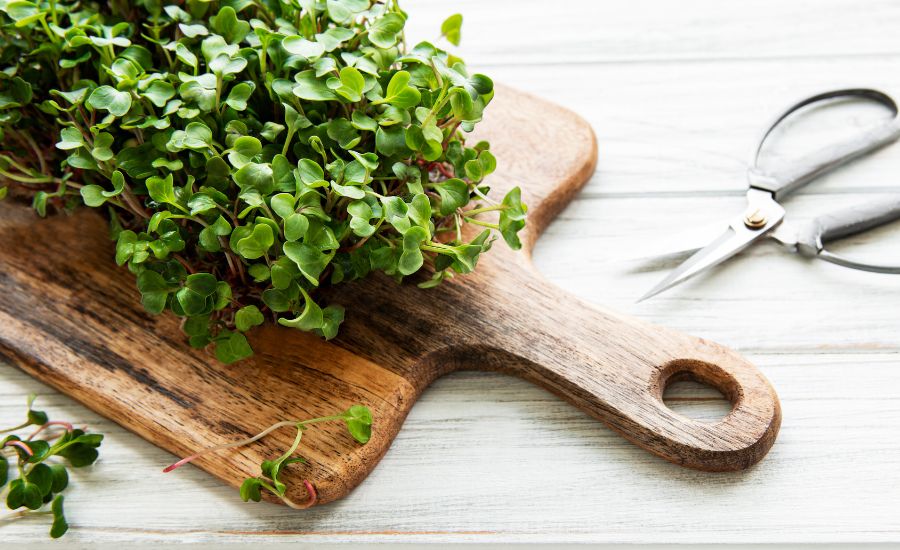
Sorrel microgreens
Sorrel microgreens are the sensitive young leaves of the sorrel plant, which is a leafy green herb with an acidic and somewhat sour flavor. Sorrel microgreens are high in nutrients and can be utilized to lend a fresh and zesty flavor to a variety of recipes.
Sorrel microgreens may have the following health benefits and culinary applications:
Sorrel microgreens are high in nutrients, and they contain vitamins A and C, as well as calcium, iron, and potassium.
Antioxidant properties, sorrel includes antioxidant chemicals that may help guard against cellular damage caused by free radicals.
Sorrel has traditionally been used as a digestive aid, and some research indicates that it may assist improve digestion and ease gastrointestinal discomfort.
Sorrel microgreens can be used in a variety of foods, including salads, sandwiches, soups, and sauces.
They impart a fresh and tangy flavor that complements fish, poultry, and other meats. Sorrel microgreens can also be made into a tasty pesto or sauce.
Sorrel has been used in traditional medicine for millennia to treat several diseases, including fever, inflammation, and skin issues. While further research is needed to establish these possible benefits, several studies have suggested that sorrel has anti-inflammatory and antibacterial effects.
Overall, sorrel microgreens are a tasty and nutritious complement to any diet, and they may provide a variety of health benefits.
Sunflower microgreens
Sunflower microgreens are the fragile juvenile leaves of the sunflower plant. Because these small greens are harvested while the plant is only a few inches tall, they are high in nutrition, flavor, and texture.
Sunflower microgreens are nutty and crisp with a moderate, somewhat sweet flavor.
They can be used to provide a pleasing crunch to some foods, including salads, sandwiches, and wraps.
These microgreens can be cultivated in soil or a soil substitute and are normally harvested when they reach a height of 1-3 inches, which takes around 1-3 weeks. They can be used to add taste, texture, and nutrients to a range of foods, including salads, sandwiches, and smoothies.
Furthermore, certain microgreens may be grown at home with minimum equipment, making them a practical and cost-effective method to add fresh greens to your diet.
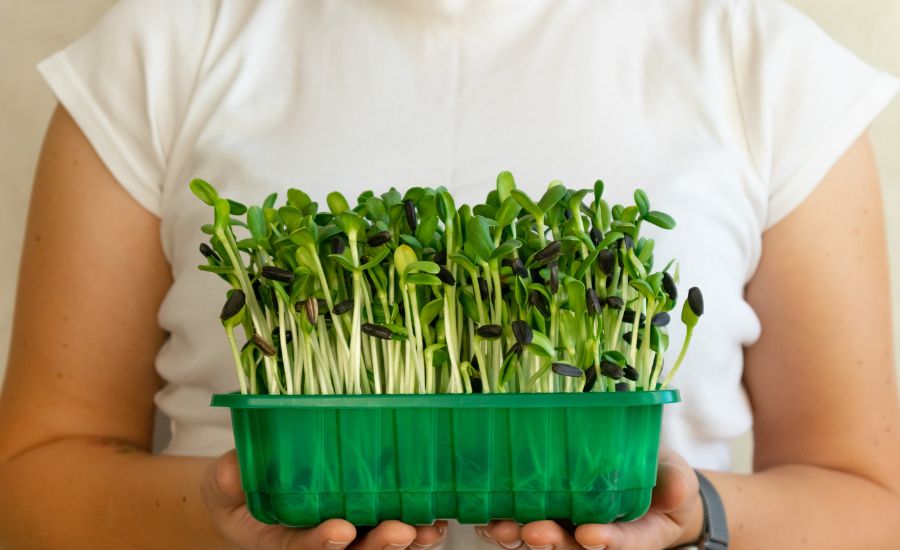
How to grow microgreens without soil?
A hydroponic system or other soilless growing mediums can be used to cultivate microgreens without soil. Here’s an easy way to cultivate microgreens without soil:
Soak your seeds by placing them in a container and covering them with water. Allow them to soak for 4-8 hours before draining the water.
Prepare your growth media as follows. Select a growing medium from the list below, such as coconut coir, peat moss, vermiculite, or paper towels. Soak the medium in water until it is damp but not soaked.
Spread the seeds. Evenly distribute the moistened seeds throughout the surface of the growing medium. Make careful to give them plenty of areas to grow.
Cover the seeds. To produce a humid environment, cover the container with a lid or plastic wrap. Allow for air circulation by leaving a tiny gap.
Place in a bright location. Place the container in a bright location, but not directly in the sun. Microgreens do not require a lot of light to grow, but they do require some.
Water the microgreens regularly to maintain the growing medium moist. Overwatering might cause the seeds to decay, so take care not to overwater.
Harvesting. When the microgreens have achieved the required size, usually after 7-14 days, cut them slightly above the growing medium.
Microgreens without soil are a quick and easy way to get fresh, nutritious greens at home. It also lowers the chance of contamination and facilitates cleanup.
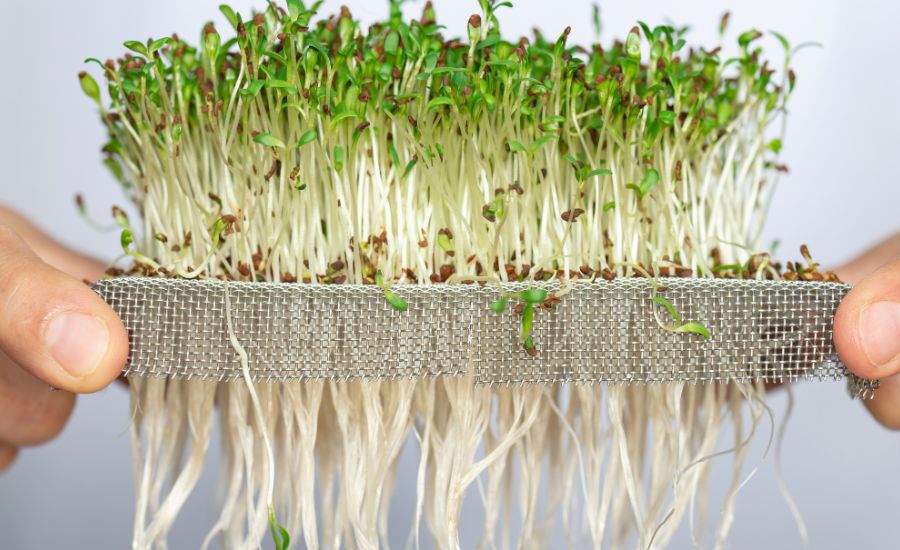
Advantages
Microgreens have numerous health benefits, including:
High health benefits. Microgreens have high nutritional benefits since they are high in nutrients such as vitamins, minerals, and antioxidants. According to certain research, they may contain up to 40 times more nutrients than their mature counterparts.
Easy to grow. Microgreens seeds are quite simple to grow at home, even in small places. They can be grown in soil or hydroponically and require little maintenance.
Easy to harvest. Microgreens seeds may be harvested in a few weeks, making them an easy and handy option for microgreens to eat and to add fresh greens to your diet.
Versatile. Microgreens are versatile and can be used in a variety of foods such as salads, sandwiches, wraps, smoothies, and more. They enhance the flavor, texture, and nutrition of any dish.
Sustainable. Microgreens may be produced in small places all year, giving them a sustainable and environmentally beneficial source of fresh produce.
Cost-effective. Growing your microgreens to eat, can be a cost-effective option to add fresh greens to your diet, as they are often more expensive when purchased pre-packaged at the grocery store.
Overall, microgreens are a versatile, practical, and nutritious supplement to any diet.
Disadvantages
While microgreens have various advantages, there are also drawbacks to consider:
Contamination risk. Growing microgreens in soil or other growing mediums increase the danger of pathogen contamination by E. coli or Salmonella. Proper growth and handling techniques can assist to reduce this risk.
Cost. While cultivating your microgreens can be economical, purchasing pre-packaged microgreens at the grocery store can be costly when compared to other types of food.
Shelf life. Microgreens have a shorter shelf life than mature greens, usually lasting only a few days in the fridge. If they are not used soon, they may go to waste.
While some studies have revealed that microgreens may have health benefits, additional research is needed to completely understand their nutritional worth and health consequences.
Taste. While many individuals appreciate the distinct flavors of microgreens, others may find them too intense.
Overall, microgreens are regarded as safe and nutritious, but before introducing them into your diet, you should be informed of the potential risks and restrictions.
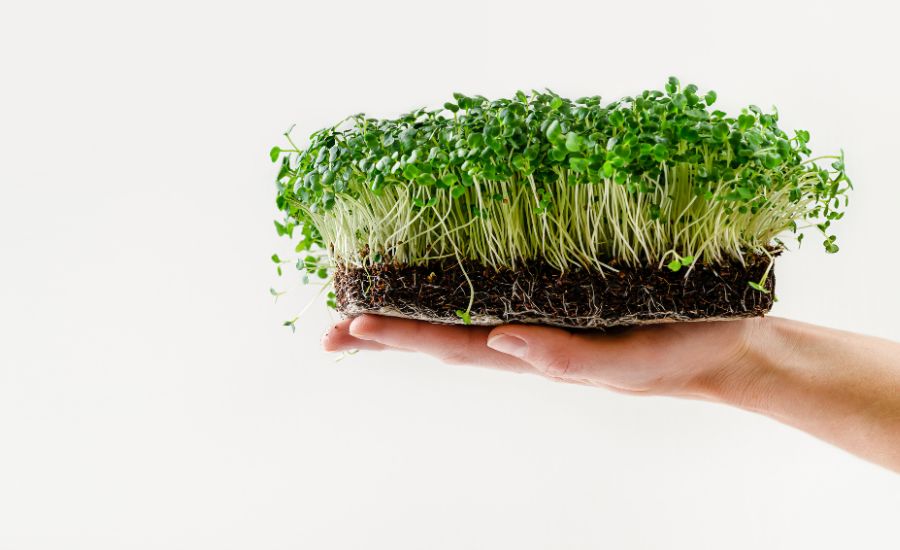
FAQ
What is the healthiest microgreen?
Microgreens are immature plants picked after they have sprouted but before they reach maturity. They are popular in salads, smoothies, and other foods due to their powerful flavor, vibrant colors, and high vitamin content.
While the nutritional value of different types of microgreens varies, some of the healthiest microgreens include:
Broccoli microgreens are high in antioxidants, vitamins A, C, and K, as well as calcium, iron, and fiber. They have anti-cancer properties and may aid in cholesterol reduction.
Kale microgreens are a good source of vitamins A, C, and K, as well as calcium, iron, and antioxidants. They may aid in reducing inflammation and improving heart health.
Red cabbage microgreens contain a lot of vitamin C, antioxidants, and anti-inflammatory chemicals. They may help reduce the risk of cardiovascular disease, cancer, and other chronic disorders.
Pea shoots. Pea shoots contain vitamin C, folate, and fiber. They also include plant components that may aid in the reduction of blood sugar levels and the improvement of digestive health.
It’s important to note that the nutritional value of microgreens varies based on several factors, including seed type, growth conditions, and harvest time.
Incorporating a variety of microgreens into your diet, on the other hand, can bring several health benefits.
Are microgreens really healthier?
Many people believe that nutritious microgreens are healthier than mature plants since they are collected at an early stage of growth while the plant is still full of nutrients. Nutritious Microgreens have been found in studies to have up to 40 times more nutrients than their fully grown counterparts, making them an excellent supplement to a healthy diet.
One study published in the Journal of Agricultural and Food Chemistry discovered that red cabbage microgreens had 6 times the vitamin C and 40 times the vitamin E of mature red cabbage.
Another study published in the International Journal of Food Sciences and Nutrition discovered that red amaranth microgreens had more than three times the calcium and eight times the iron of mature amaranth.
Microgreens are also high in antioxidants, which can help protect cells from free radical damage. Furthermore, they may aid in the reduction of inflammation, the reduction of cholesterol and blood sugar levels, and the promotion of healthy digestion.
While more research is needed to completely understand the health advantages of microgreens, there is evidence that they can be a nutritious supplement to a well-balanced diet.
Which is healthier microgreens or sprouts?
Both own microgreens and sprouts are healthy and nutritious, however, their nutritional profiles and growing processes differ.
Sprouts like radish sprouts have a lot of health benefits and are germinated seeds that are consumed in their entirety, including the seed, root, and stem. They are usually grown in water without soil and harvested after only a few days. Sprouts are high in nutrients and low in calories.
They have a lot of health benefits and they are high in vitamins C and K, folate, fiber, and antioxidants. They are also a fantastic source of protein and may help with digestion and immunological function.
Microgreens, on the other hand, are young plants taken after they have reached the seedling stage but before they reach maturity. They are produced in soil or a soil replacement, require more light than sprouts, and grow slower.
Growing Microgreens are also high in minerals, such as vitamins A, C, and K, as well as calcium, iron, and antioxidants. They may aid in the reduction of inflammation, the reduction of cholesterol and blood sugar levels, and the promotion of healthy digestion.
So, while both growing microgreens and sprouts are nutritious, their nutritional profiles and advantages differ.
Microgreens are often higher in nutrients than sprouts and provide a broader spectrum of nutrients, although sprouts are strong in protein and may have specific health benefits.
Finally, eating a variety of microgreens and sprouts can provide a variety of health advantages and nutrient diversity.
What are the sprouts’ health benefits?
Sprouts, often known as “sprots” or “sprouted seeds,” are immature plants that sprout from seeds. Sprouts are generally seen to be very healthful and nutritious, with a variety of potential health advantages, including:
Sprouts are high in vitamins, minerals, and antioxidants, including vitamins A, C, and E, as well as iron, magnesium, and zinc.
Improved digestion
Sprouts include enzymes that can aid in digestion and nutrition absorption in the body.
Reduced inflammation
Some research suggests that sprouts have anti-inflammatory qualities that can help reduce the risk of chronic diseases like heart disease, diabetes, and cancer.
Lowering cholesterol
According to some research, sprouts may help lower cholesterol levels and enhance heart health.
Enhanced blood sugar control
Some research suggests eating sprouts can help enhance insulin sensitivity and reduce blood sugar levels.
Sprouts include chemicals that can help boost the immune system and defend against illnesses.
Weight loss
Sprouts are high in fiber and low in calories, which might assist increase feelings of fullness and aid in weight loss.
It’s worth noting that some sprouts, such as alfalfa sprouts, have been linked to foodborne diseases.
This risk can be reduced by using proper growing, handling, and cooking techniques. Raw sprouts should also be avoided by persons with compromised immune systems, such as pregnant women, small children, and the elderly.
What are the best microgreens to grow at home?
There are numerous forms of microgreens to grow at home, but the following are some of the simplest and most popular:
Radish microgreens. These are quick to cultivate and have a sharp and peppery flavor that adds a kick to salads and sandwiches.
Pea microgreens. Sweet and tender, with a subtle flavor that complements a range of recipes.
Sunflower microgreens. Theyare rich and nutty, with a somewhat sweet flavor that can be used to give depth to salads and sandwiches.
Beet microgreens. They are earthy and slightly sweet, with a vivid red hue that complements salads and other foods.
Mustard microgreens. Theyhave a spicy, pungent flavor that can be used in salads, sandwiches, and other foods.
Broccoli microgreens. These have a moderate, somewhat nutty flavor and a variety of health benefits.
Overall, the greatest microgreens to grow at home will be determined by your particular preferences as well as the types of recipes you enjoy cooking. It’s a good idea to try different varieties to see which microgreens to grow at home.
Conclusion
Growing microgreens is a great idea because they are a nutritious and healthful supplement to any diet. While the nutritional value of different varieties of microgreens varies, some of the healthiest microgreens are broccoli, kale, red cabbage, and pea shoots.
Microgreens are high in nutrients such as vitamins, minerals, and antioxidants, and they may help reduce inflammation, lower cholesterol, and blood sugar levels, and promote good digestion.
Including a variety of healthiest microgreens in your diet can provide a variety of health benefits as well as nutrient diversity. So, if you want to increase your nutrient intake, try adding some of the healthiest microgreens to your diet.

